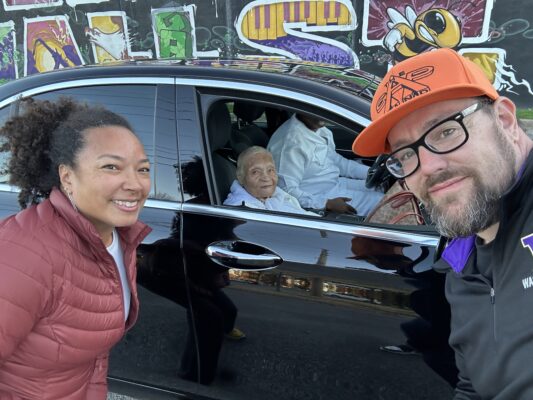Last year, Sankofa Impact conducted a small-scale trip to Tulsa, Oklahoma to visit and research the events of the Tulsa massacre in 1921. The trip was conducted by Felicia Ishino and Nathan Bean for community members, Lester and Holly Hartman. The journey was requested by the Hartman’s, as an illness has begun to significantly hinder Lester’s ability to travel. A trip to Tulsa to wrestle with the legacy of the massacre was something that he felt passionate about and Sankofa Impact was proud to walk with him in this endeavor.
The experience was powerful. We had coffee every morning at the Black-owned Black Wall Street Liquid Lounge. There, we set the agenda for the day and built community among our small group of travelers. On our first day we took a walking tour of the historic Greenwood neighborhood, once a bustling community, now reduced to a single block. Unavoidable was the sound and fury of interstate highway I-244, which runs right through the heart of Greenwood. This is an all too common scene in too many urban Black communities.
More than a few Tulsa residents would remark to our group that there were two massacres. Many know that the massacre in 1921 was brutal and widespread. Very few know that the Black residents of Tulsa built back their Greenwood neighborhood, this time with brick. Folks shared with us the details surrounding the second massacre: the destructive impact of eminent domain and racist development policies that rendered Greenwood near obsolete by the 1990s.
Over three days, our group took a walking tour of Greenwood, prayed at John Hope Franklin Reconciliation Park, visited Silhouette Sneakers & Art, ate elevated soul food at Fixins Soul Kitchen, and attended an event hosted by award-winning author and journalist Victor Luckerson, whose book “Built from the Fire: The Epic Story of Tulsa’s Greenwood District, America’s Black Wall Street” is a comprehensive account of the Tulsa massacre.
Dubbed “Black Wall Street,” in the early 20th century, Greenwood grew and flourished as a Black economic and cultural mecca—until May 31, 1921. A young Black man was accused of harassing a white woman. A white mob began a rampage through some 35 square blocks killing more than 300, burning hundreds of Black-owned businesses, and leaving as many as 10,000 people without a home.
Perhaps the most moving visit for our group was at the Greenwood Rising Museum. The museum offers a comprehensive look into the lives of Black Tulsans before, during, and after the massacre through immersive exhibits, interactive displays, and multimedia presentations. It aims to educate visitors about the impact of racial violence, the history of systemic racism, and the importance of reconciliation and healing. Greenwood Rising not only serves as a memorial to the victims and survivors of the massacre but also as a cultural and educational hub that promotes social justice and equality.
The group was moved by every corner of the Greenwood neighborhood and the learnings were plentyful. There are two instances that really stood out during our time in Tulsa. One is the way Lester Hartman showed up everyday. In a consistent state of pain and limited mobility, Lester reckoned with the legacy of whiteness and the role it played in the Tulsa massacre. He also located his own life and whiteness and the role it has played during his life. In a season of his life when it would be so easy to ignore this discomfort, he embraced it. That willingness is an inspiration.
The second moment was an unplanned meeting. As Felicia and Nathan were taking photographs of the Black Wall Street Mural, a car pulled up nearby. The window was lowered and a man’s voice from the driver’s seat said, “the photo you really want is inside this car!” Not knowing what this meant, we looked into the car with skepticism. In the passenger side was an older Black woman who looked familiar. She smiled at us as the driver said, “This is Mother Viola Ford Fletcher ” Just then, it dawned on us that this was one of two living survivors of the Tulsa massacre. What a moment. We asked her about the key to her 110 years on the planet. She said simply, “a lot of rest.”

Last week, the Oklahoma Supreme Court dismissed a lawsuit arguing that the remaining survivors of the 1921 Tulsa Race Massacre, Mother Fletcher and Lessie Benningfield Randle, should be compensated by the city for damages, dealing a blow to their ongoing fight for reparations more than 100 years after the attack. We’ve heard so many Black Tulsans refer to reparations, maybe because the link is so deeply felt by so many. How can people like Mother Fletcher rest without reparations? Perhaps Lester felt such unrest about the way things are that he chose to confront our shared history, despite the barriers. Ultimately, reparations will not guarantee rest for all those harmed by racist oppression, but it may create the conditions. Rest. Thrive. Liberate.
